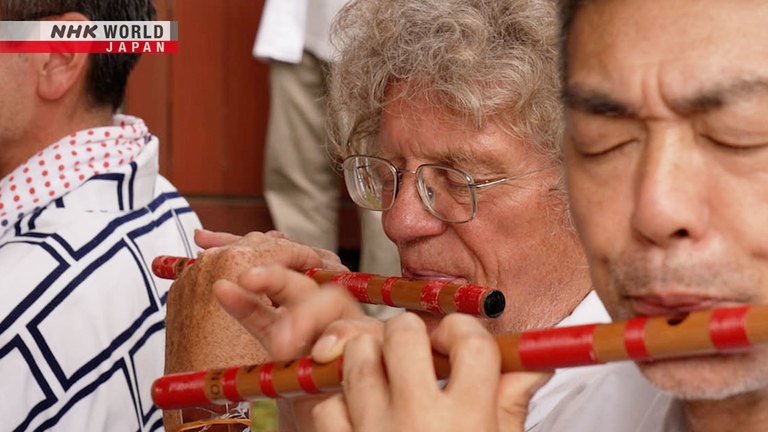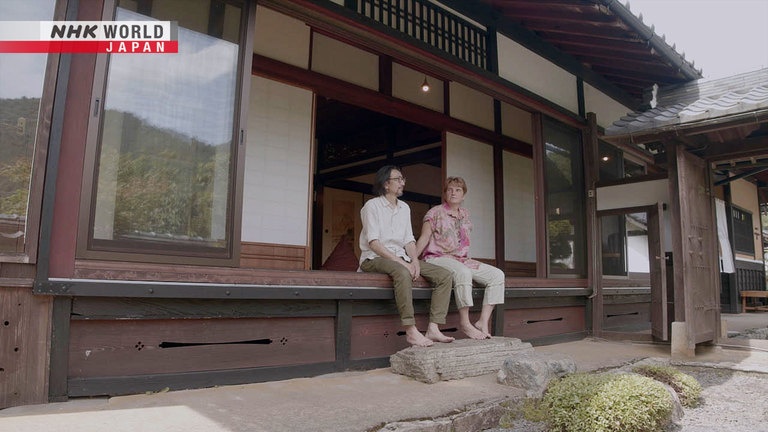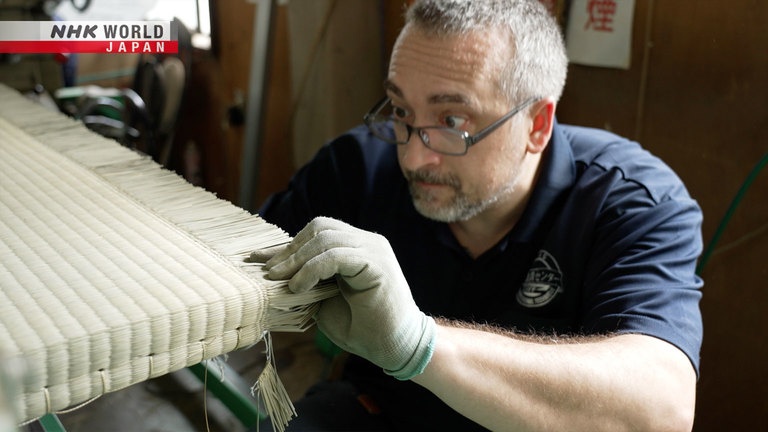Living it Slow in Rural Japan
This time, we discover the enchanting natural landscape of Miyama in Kyoto Prefecture. Drawn to the appeal of a slowly paced life in the Japanese countryside, some foreigners have settled down in the region. We follow Spanish photographer Tina Bagué as she captures images of fellow non-Japanese who moved to Miyama - an American yoga master, a French organic farmer and a German shakuhachi player. We also visit Beppu in Oita Prefecture to meet Ukrainian Denys Kralikauskas who makes and mends tatami mats.




Transcript
Here, you can feel the change in seasons.
Miyama is the best.
Where We Call Home.
Meet Tina Bague, a photographer from Spain.
She turns her camera to the foreigners who, like her, settled down in the town of Miyama in Kyoto Prefecture.
Miyama is paradise, finding paradise.
I wanted to do meaningful work,
not just for money.
What is it that draws them to Miyama?
Through her viewfinder, Tina discovers a new appeal to the region.
What images will she capture?
Let's take a look!
Here we are about a one-and-a-half-hour drive from central Kyoto City.
Part of Nantan City, the town of Miyama is nestled between mountains.
It's a quintessential example of what Japanese call "satoyama" -
a region where people live in harmony with nature.
Photographing the local landscape is Tina Bague, who moved here from her native Spain.
Here, really...
You can feel the change of the seasons and how the flowers come out every day in a different way and...
spring, summer, autumn, winter, snow...
You know, it's a...
It's a luxury to be in Miyama, enjoying all these changes.
Born in Barcelona, Tina was a shutterbug since she was a child.
As a travel photographer she immortalized scenes from the simple everyday lives of people around the globe.
At the age of twenty-six she met fellow lensman Morimoto Toru,
who was working in Spain at the time, and they got married.
This is where the two have made their home...
Hi!
Welcome to Casa Miyama!
... in a refurbished 113-year-old Japanese-style house.
Have a look here.
Before finding this ideal location for their casa,
Tina and Toru traveled throughout the country to photograph the daily lives of people everywhere they went, and published a photo book.
They found that Miyama, where people live close to nature, was the perfect place,
and so they moved here in 2020.
When I saw this garden,
I knew we had to buy this house.
The property had such a wonderful garden.
It looked like a scene from a movie.
It's often misty.
After the rain yesterday,
the mountains got misty. It was lovely.
- Like an ink painting.
- Yes.
I love the scenery here, with rivers,
mountains and lots of greenery.
To the old-fashioned charm of the house, they added a modern twist,
and turned part of it into a small inn for one group of guests per night to get a taste of the Japanese country life.
Visiting from the city today is a Japanese family spanning three generations.
Bon appétit!
How do they like Miyama?
The river was fun!
Such beautiful nature.
The scenery is great.
It's been three years since the couple settled down in Miyama.
Tina has started a new project.
I thought it would be interesting to take portraits of foreigners living in Miyama.
It was good to take pictures of them in their environment and see how they...
how they live the Miyama life on their own way.
She wondered how to best capture in photo the hearts and minds of non-Japanese living in Miyama,
and asked Toru for suggestions.
- What sort of locations?
- This is Miyama; it has to be nature.
Places unique to each person.
He showed her a very old camera - the kind that was used more than a hundred years ago.
Taking photos with it is a long process, but it produces images with a distinctive feel.
Toru's idea inspired Tina to look for a unique photographic method
that would reflect the characteristic slow pace of living in Miyama.
To better photograph their 'slow life,'
I want to use a 'slow technique.'
One of the aspects of life here that charms Tina
is how proximity to nature gives her a front-row seat to the passing of seasons.
And so, she sets out to meet foreigners like herself who enjoy living in Miyama at a leisurely pace.
Today, she heads to Kawauchidani, an area where a lot of the natural landscape has been left untouched.
She points her lens to yoga master Duncan Wong.
Born in California in 1968, Duncan had a troubled adolescence, constantly getting into fights.
But in his late teens, he discovered yoga, which changed his life.
After studying in India, he incorporated martial-art forms into an original kind of yoga that earned him international attention.
Duncan explains that, of all the places he's seen, Miyama is the best to practice yoga.
Miyama is paradise. Miyama is like finding paradise.
It's like earthing, it's like grounding.
It's really Zen life.
Just standing on the earth and feeling the power of nature.
The air smells like flower,
the water is pure blue,
the wind blows through the "tanbo."
And living with the animals, living in balance with nature.
So, this is paradise.
I love Miyama!
Can you look here?
Tina wants to photograph an instance when, as Duncan describes it, he becomes one with nature.
His body and physique say it all.
He gives off an energy...
There's a flow going around.
I think the picture will show that feeling.
Next, Tina pays a visit to a man who made natural farming his vocation -
Michel Kaiser from France.
It's lovely here.
We're close to a river,
there's lots of sunlight.
My fields face south.
It's great for growing vegetables.
Michel imports seeds from places like France and Italy to grow somewhat unconventional vegetables.
He was born in the eastern countryside of France.
After university, he came to Japan as part of a volunteer program to experience farming, which is how he found his calling.
He then moved to Miyama.
Implementing time-consuming techniques such as smoking rice chaff to turn it into fertilizer,
he produces safe and healthy vegetables the organic way.
I wanted to do meaningful work,
not just for money.
And I wanted our son to eat
healthy vegetables.
That's the most important.
Michel lives with his wife and their son Oto.
For him, this slow passage of time he enjoys with his family is invaluable.
It's nice there are people like him
in this digital era.
He has a dream.
His concept for life is really amazing.
Life in Miyama really suits him.
He found the perfect place.
Tina also gives importance to staying connected to her community.
The local table tennis tournament...
For Tina, it's an occasion to socialize with her neighbors.
Since Tina came, we made these tables
and people come to play.
It's a new gathering place
for the people here.
It's bread from a famous bakery in Kyoto.
It's really good.
I saved half of it for you.
"Osuso-wake" - this old Japanese custom of sharing with others food and other things one receives
is yet another part of life in Miyama Tina appreciates.
This summer, Miyama's Ta-uta district holds a festival with more than three hundred years of history.
Through centuries, such festivals to pray for a bountiful harvest have been held all over Japan -
reflecting the country's ancient nature-worshipping traditions.
However, with the current rural depopulation, such celebrations are slowly fading away.
In Miyama, younger generations who moved here help preserve the tradition.
Tina spots a fellow non-Japanese who settled down here.
Uwe Walter.
Tina wants to conclude this series of photographs with Uwe, who's been in Miyama for thirty-three years.
He was born in East Germany in 1954.
Hoping to find freedom, his mother fled to West Germany with him while he was still an infant.
He came to Japan at the age of twenty-seven.
While working as a musician and street performer, he fell in love with the traditional instrument "shakuhachi."
Uwe chose to put down roots in Miyama
as he feels it's an ideal place to harmonize the sound of his shakuhachi with nature.
Uwe plays in unison with the sounds of the forest and the animals that inhabit it.
It has a spiritual aspect.
When I play, I extend some notes
and cut others short.
It's like the sound of the wind.
It isn't a fixed rhythm.
It fluctuates. So, the silence
after notes is more important.
The notes I play aren't mine.
They belong to nature.
The sound lives with nature.
Tina comes to Uwe's house.
Hello!
- May I?
- Come in!
I'd like to take pictures of you today.
I know just the spot. It's like a stage.
I'll dance there with my shakuhachi.
It's like a prayer for me.
It's amazing. You've become Japanese.
The two decide to take photos where the sacred trees for the festival are enshrined.
Stand between the trees.
I'll photograph you from a distance.
The sound of the shakuhachi
fits so nicely with nature.
The sounds, and the face, and the pose, and... the scenery: every melts.
And I think it's perfect for the sound of the flute, it's really good.
The music of Uwe's shakuhachi blends in with Miyama's nature and tradition.
Tina wants to fully capture his joy of living in the region.
Now that the photos are all taken...
There's one more thing Tina wishes to do.
She wants to make negatives of the digital photos she took
and produce prints called cyanotypes following an old method that uses natural sunlight.
The light of the sun will hit the paper
and change its color.
The image will appear on the paper.
I think it's good to use a technique that has to deal with nature.
It's the picture that comes out when you wash it with water, and you print it with the sun.
So, you are using natural elements to get your picture done...
So, this process, analog photography, takes time.
It's a slow technique.
It mirrors life in Miyama perfectly.
Lastly, she rinses off the chemicals, and the photos are done.
It's born!
It's like my child.
Tina's project to depict in photo the essence of foreigners who love Miyama's slow-paced life is finally complete.
Duncan, who blends nature's power and the spirit of martial arts into yoga.
Michel, a farmer gentle to mother nature who treasures time spent with his family.
And Uwe, who plays on his shakuhachi sounds that harmonize with both nature and culture.
Tina now sees Miyama in a new light.
You can feel the change of the seasons, and how the flowers come out every day in a different way,
and it's a luxury to be in Miyama, enjoying all these changes.
... being in a place like this to enjoy life in its maximum.
Japanese say, "saiko," no? "Saiko!"
Miyama is "saiko(the best)."
I'm Denys. I'm 45.
I'm from Ukraine.
I work making and repairing tatami mats.
I want to be the best tatami
craftsman in Japan.
Beppu, Oita Prefecture.
Denys works for a company specializing
in interiors for Japanese-style houses.
He's in charge of tatami mats,
traditional flooring.
For over a millennium, the mats have been
made of a plant strong against humidity.
Tatami craftspeople repair
and make new tatami mats.
Going to pick up tatami
that need repair.
Stairs?
- No elevator?
- No.
This is a test.
Having passed the year mark, Denys is put
in charge of the mats in this room.
He checks the old tatami's
level of wear and shrinkage.
He puts a '0' which means 'no change in size.'
Denys.
The cover shifted under pressure.
His supervisor uses a translation app.
You should put a minus here, not zero.
The tatami warped as they pressed against
one another, and so need adjusting.
Here.
Back at the workshop,
the mats are first dried.
I removed the old coverings
to repair the cores of the mats.
He patches holes in the mat's core
with strips of tatami covering.
He then puts new covering on the mat.
The ends are strengthened with special
brocade, which he sews onto the mat.
There are no tatami in other countries.
It's an interesting culture...
that's unique to Japan.
I'm far from being
a full-fledged artisan.
But it's a great honor
and very interesting...
to be working so close to this tradition.
Born in Donetsk, Denys
ran a construction firm.
But with Russia's invasion,
he was forced to evacuate abroad.
With the help of a Ukrainian woman
who'd lived in Japan for a long time...
he and his family could come to Japan.
I'm home!
Hi!
Come in.
The family of five now live in Beppu City.
We have nowhere to go back to.
We've lived through eight years of war.
We don't want to go back.
We left our friends and property behind.
We won't go back.
Denys wanted to make use
of his experience in construction.
I saw the ad and knew I wanted this job.
I was very interested in
the Japanese tradition of tatami mats.
I was curious to learn
how the covering is made.
This is my friend and mentor,
Watanabe-san.
He's still a beginner.
But I can rely on him.
There's still a limit to what he can do,
but he's reliable.
He has to think for himself
to be able to improve.
So, I make sure not to teach him
more than he needs to learn.
Yes, I feel so, too.
Every tatami, every room is different.
We have to think and adapt to each.
He doesn't need to be like me.
I want Denys to become a craftsman
according to his own vision.
My car is like my partner.
It's probably my most valuable possession.
Denys and his family have gone
on drives to many places in Japan.
Everywhere I go,
it gives me a fresh new feeling.
It's exciting.
Our feelings and memories are invaluable.